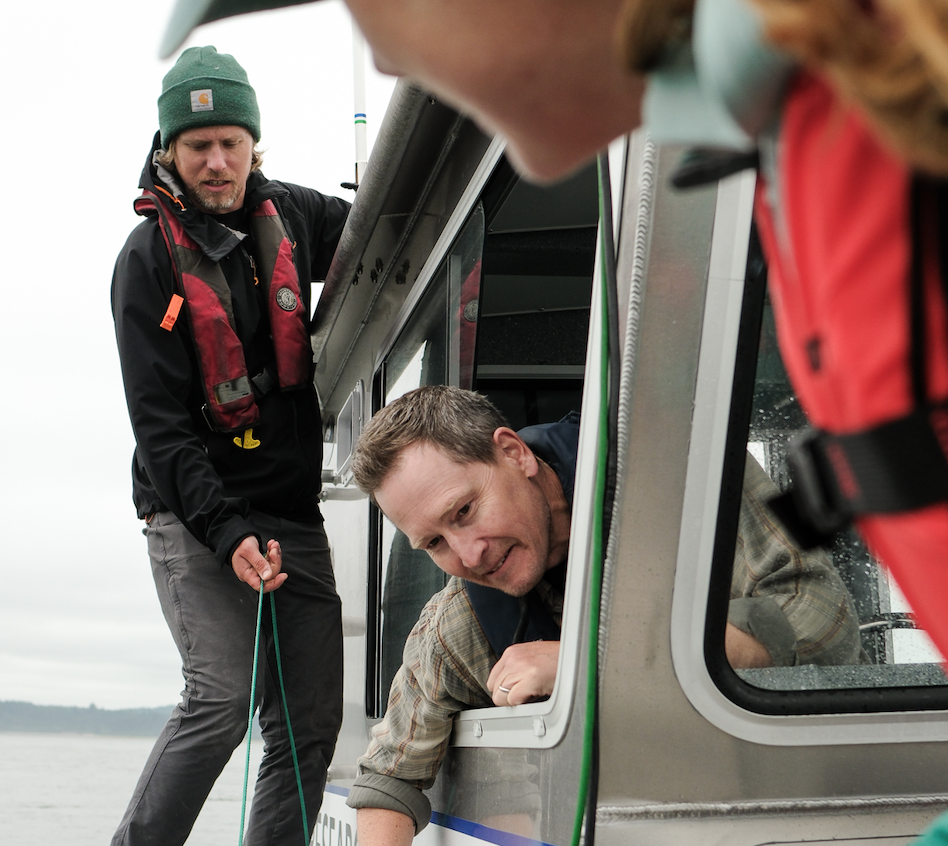Explore Washington’s treasure trove of tidepools
Published 7:40 am Monday, September 20, 2021

- Lined chiton (Tonicella lineata) and Mossy chiton (Mopalia muscosa) graze on coralline algae. This rock also has purple sponge (Haliclona permollis).
As tides roll back in rocky shores, they reveal a treasure trove of Washington’s marine biodiversity. Explore rainbows of bright green, orange, purple, pink, blue and red. Celebrate your #LifeOutdoors and take advantage of every opportunity to observe and learn about life under the sea. With constant changes in water level, living in intertidal habitats can be tough. However, Washington coastlines are a great place to celebrate the biodiversity of our state. Before we learn about tidepools, we should first learn about the physical forces that create tidepools. Tidepools are a great way for us to peek at what Washington’s marine life looks like.
Trending
What are tides?
As the moon and sun switch positions in the sky, their gravitational force causes long-lasting waves in the ocean. As these waves reach the coast, they appear as a rise (flow) and fall (ebb) of the ocean. These shifts in ocean levels along coastlines are called tides. The difference between high and low tides is known as the tidal range.Before going tidepooling, it’s important to check your local tide chart (printed each week on page A2 of the Chinook Observer). You will have the most opportunity to see a variety of intertidal life if the tide is at least –1 feet. The lowest tides of the year typically coincide with the summer and winter solstice. Additionally, the best time to go is about an hour before low tide. To learn more about how to read a tide table, check out this article from REI: tinyurl.com/How-to-read-a-tide-table.
What are tidepools?
The ebb and flow of the ocean along the coast makes intertidal habitats places of constant change. At high tide, organisms must withstand the constant drumming of waves against the shoreline. As the tides begin to recede, these organisms face increased stress from sunlight and warmer water temperatures, lower oxygen levels, and predators like shorebirds and small mammals.
Trending
When tides ebb, they leave behind water in the cracks, depressions, and holes of our complex coastlines. These pools serve as a low-tide habitat for organisms that require saltwater such as barnacles, limpets, chitons, algae, mussels, anemones, nudibranchs, sea stars, urchins, sculpins, crabs, seaweeds, and more! Tidepools vary greatly in size, some are feet long while others may only be a few inches.
Where are tidepools?
Tidepools are most common along rocky shores of coastal Washington and Puget Sound. However, pools can also be along sandy beaches or in mudflats. Depending on where you go, you may find habitats that support different types of intertidal marine life. In Washington, the tidal range is large enough that when tides change, different tidal zones become exposed. Tidepools can be found between the low tide zone and the high tide zone. You are likely to find different types of intertidal organisms in the high tide zone than in the low tide zone. The lower the tide, the more diversity of life you might see. Extreme low tides of -2.5 feet or greater will expose the most marine life.
In Pacific County, the outer coast cliffs and rocks in Cape Disappointment State Park provide the most interesting and accessible place to observe tide pool creatures.
What kinds of intertidal life am I likely to find in Washington?
Tidepools are a great chance for you and your family to hone observational skills. By going slowly and waiting, you might see fish and crabs come out from under seaweed or move among rocks. To identify species, print out an identification guide (for example tinyurl.com/Olympic-coast-fieldguide), or try using the free iNaturalist app (www.inaturalist.org) on your smartphone. Here are just a few of the most common organisms you might see. Don’t forget to look all around you as many marine and avian animals are also found in and around tidepools.
Coralline algae Corallinaceae
In most rocky shore tidepools you are guaranteed to see coralline algae. Coralline algae is a magenta pink plant partially made of calcium. It is a resilient species that requires less sunlight than other sea plants so it can live deep in rocky crevices and sea caves. Its magenta crust is composed of layers of cells and once these layers are attached to rocks, they are not easily moved. Coralline algae are eaten by limpets, snails, and chitons. Scientists have recently found that coralline algae that forms crusts on rocks may indicate increased ocean acidity due to carbon increase. Higher acidity impacts the species’ ability to build and form calcium, making it sensitive to changes in ocean chemistry.
Gooseneck barnacles Pollicipes polymerus
When most people think of barnacles, they think of acorn barnacles, which are volcano shaped organisms that cover rocks. Gooseneck barnacles however are commonly found in beds with California mussels. They grow out of a long tube above the rock’s surface. When exposed to air, hard plates protect the barnacle and underwater the plates open and a hairy creature is revealed. Gooseneck barnacles are a common snack for shorebirds such as gulls and black oystercatchers as well as ochre sea stars.
Giant green anemone Anthopleura xanthogrammica
Anemones are a group of animals related to jellyfish and corals. They use stinging cells in their rubbery arms to stun prey like fish and small invertebrates. The giant green anemone also receives energy from algae that live in its tissues. Anemones don’t have a digestive system, so their disc-shaped mouth also excretes their waste. Yup, that means they poop out of their mouth! Be careful when walking in tidepool areas at low tide as many anemones close up and become covered in sand, making it easy to mistake them for a rock.
Ochre sea star Pisaster ochraceus
Ochre sea stars are a very important animal in intertidal communities. Sea stars are predators, munching on mussels, limpets, urchins, and other mollusks. Sea stars have thousands of tiny tube feet that help them move, climb onto prey, and pull open shells. Ochre sea stars are vulnerable to gulls and other avian predators when out of water too long, so make sure to not pick any up or move them. Ochre sea star populations on the Pacific Coast are recovering from sea star wasting syndrome, a deadly virus that caused mass die-offs of this important predator.
Sea lettuce Ulva fenestrata
Sea lettuce is one species of green algae. Its Latin name, fenestrata means holes or windows. When you observe sea lettuce in tidepools you’ll know why! You may also see lettuce on rocks or floating in the ocean. This alga is an important food species for marine invertebrates, sea worms, and humans! It is high in protein, vitamins, and minerals.
Chitons multiple genera
Chitons are a prehistoric mollusk. Some chiton fossils have been dated back to 400 million years ago. This means they are older than some dinosaurs! Chitons have eight overlapping plates that give them an armored appearance. Their size varies from less than one inch to over one foot in length. They have one foot that helps them move across and stick to rocks. When removed from rocks chitons will form a ball to protect their soft underside. Some chitons eat algae that is hardened on rocks while others eat sponge and zooplankton. Predators of chitons include sea stars, sea ducks, and sometimes sea otters.
Health and safety
When tidepooling, your safety is important. Review these recommendations to make sure you and your family have a safe and enjoyable experience:
Don’t leap, skip, or jump across rocks. They can be slippery and sharp.
Wear waterproof and sturdy shoes with good grip; algae and seaweed make rocks slippery and barnacles can be sharp!
Never turn your back to the ocean. Sneaker waves and incoming tides can be a hazard: www.weather.gov/safety/ripcurrent-waves.
Make sure children are familiar with tidepool etiquette and dressed appropriately.
Tidepool etiquette
Remember you are visiting another’s home. Be respectful of the plants and animals who live in tidepools. This includes picking up any trash you may drop or find, not picking up or removing creatures from their homes, and returning rocks to the position you found them in so that animals don’t die by exposure to the sun.
Keep dogs and other pets at home. Sharp mussels and rocks can be dangerous for pets. Additionally, pets, no matter how well trained, may accidentally harm intertidal life.
Make sure your hands are free and clean of chemicals like sunscreen, lotions, and hand sanitizers if you decide to touch any tidepools animals. These chemicals can harm marine and intertidal life.
Extreme heat events (over 95 degrees Fahrenheit) add extra stress to the survival of intertidal species. Remember tidepool animals already live in constantly changing conditions so any added stress may reduce an animal’s ability to withstand the already rugged environment. During such heat waves, be mindful of these impacts on tidepool life and plan your day around a different coastal activity.
Before heading to a tidepool, make sure you know the area’s rules and regulations. For more information, check out this tidepool etiquette list from the National Oceanic and Atmospheric Administration: olympiccoast.noaa.gov/living/habitats/intertidal/ettiquette.html.









